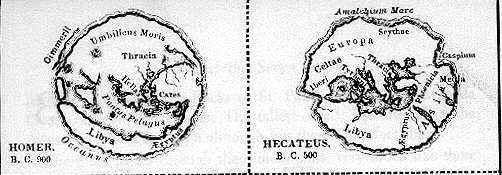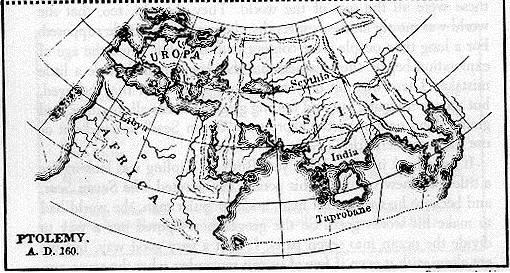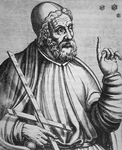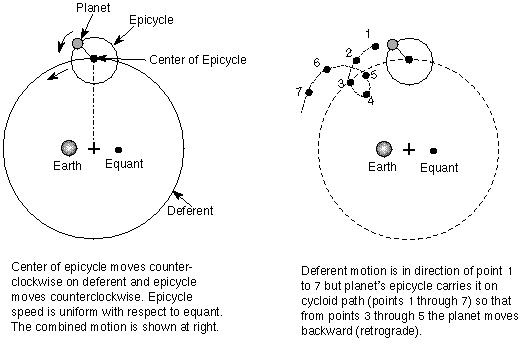
Ancient Greece's view of their world. Select the image to go to Jim Siebold's ancient maps database from which this picture came.
This material (and line art) is copyrighted!. See my copyright notice for fair use practices.
This chapter covers the development of western astronomy and modern science. I focus on the rise of modern science in Europe, from the ancient Greeks to Isaac Newton. Other cultures were also quite interested and skilled in astronomy (the Mayans, Egyptians, peoples of India and China come immediately to mind), but the Greeks were the first ones to try to explain how the universe worked in a logical, systematic manner using models and observations. Modern astronomy (and all of science) has its roots in the Greek tradition. If you would like a more thorough discussion of the history of astronomy than what I will present here, please take a look at Science and the Human Prospect by Ronald Pine. I will give dates of when certain persons lived and worked to give you some reference points in the long history of astronomy. Don't worry about memorizing the dates. What is more important is to see the development of ideas and methods of modern science.
I include images of world atlases from different time periods in this chapter and the next as another way to illustrate the advances in our understanding of our world and the universe. Links to the sites from which the photographs came are embedded in the images. Select the picture to go to the site. The vocabulary terms are in boldface.

By the 7th Century B.C.E. a common viewpoint had arisen in Greece that the Universe is a rational place following universal, natural laws and we are able to figure out those laws. Open inquiry and critical evaluation was highly valued. The emphasis was on the process of learning about the universe rather than attaining the goal. But people eventually got tired of learning and wanted absolute answers. Science is not able to give absolute, certain answers. There was disagreement among the experts and there came to be a crisis in confidence that led to the rise of the Sophists.
The Sophists taught that an absolute truth and morality are myths and are relative to the individual. Since truth and morality were just cultural inventions for the Sophists, they said a person should conform to the prevailing views, rather than resolutely holding to some belief as an absolute one. Socrates (lived 470--399 B.C.E.) disagreed with the Sophists, teaching that we can attain real truth through collaboration with others. By exploring together and being skeptical about ``common sense'' notions about the way things are, we can get a correct understanding of how our world and society operate. This idea of being skeptical so that a truer understanding of nature can be found is still very much a part of modern science.
 Socrates' student, Plato(lived 427--347 B.C.E.), developed Socrates' ideas
further. Plato taught that there are absolute truths---mathematics is the key.
While statements about the physical world will be relative to the individual and
culture, mathematics is independent of those influences: 2 + 2 = 4 always, here
on Earth or on the far side of the galaxy. Plato had Four Basic Points:
Socrates' student, Plato(lived 427--347 B.C.E.), developed Socrates' ideas
further. Plato taught that there are absolute truths---mathematics is the key.
While statements about the physical world will be relative to the individual and
culture, mathematics is independent of those influences: 2 + 2 = 4 always, here
on Earth or on the far side of the galaxy. Plato had Four Basic Points:
Out of Plato's teachings grew the belief that when one studies mathematics, one studies the mind of God. Mathematical symmetries are the language of universal design and harmony. Their faith in order caused the Greeks to try to find explanation for the seemingly unordered planets (particularly retrograde motion). Their faith in an ordered universe compelled them to make precise observations and they were sustained by their belief in the power of reason. In one form or another, modern scientists have this faith in an ordered universe and the power of human reason.
 The
Greeks were guided by a paradigm that was first articulated by Pythagoras
(picture on left) before Socrates' time.
The
Greeks were guided by a paradigm that was first articulated by Pythagoras
(picture on left) before Socrates' time.
A paradigm is a general
consensus of belief of how the world works. It is a mental framework we use to
interpret what happens around us. It is what could be called "common sense".
The Pythagorean Paradigm had three key points about the movements of
celestial objects:
Some of the observations that convinced the Greeks that the Earth was not moving are
Plato taught that since an infinite number of theories can be constructed to account for the observations, we can never empirically answer what the universe is really like. He said that we should adopt an instrumentalist view: scientific theories are just tools or calculation devices and are not to be interpreted as real. Any generalizations we make may be shown to be false in the future and, also, some of our false generalizations can actually ``work''--an incorrect theory can explain the observations (see the scientific method page for background material on this).
Aristotle chose this model because most popular and observational evidence
supported it and his physics and theory of motion necessitated a
geocentric (Earth-centered) universe. In his theory of motion, things
naturally move to the center of the Earth and the only way to deviate from that
is to have a force applied to the object. So a ball thrown parallel to the
ground must have a force continually pushing it along. This idea was
unchallenged for almost two thousand years until Galileo showed experimentally
that things will not move or change their motion unless a force is
applied. Also, the crystalline spheres model agreed with the Pythagorean
paradigm of uniform, circular motion (see the previous
section).
Astronomers continued working on models of how the planets moved. In order to
explain the retrograde motion some models used epicycles---small circles
attached to larger circles centered on the Earth. The planet was on the epicycle
so it executed a smaller circular motion as it moved around the Earth. This
meant that the planet's distance from us changed and if the epicyclic motion was
in the same direction (e.g., counter-clockwise) as the overall motion around the
Earth, the planet would be closer to the Earth as the epicycle carried the
planet backward with respect to the usual eastward motion. This explained why
planets are brighter as they retrogress.
 Aristotle (lived 384--322 B.C.E.) was a student of Plato and
had probably the most significant influence on many fields of studies (science,
theology, philosophy, etc.) of any single person in history. He thought that
Plato had gone too far with his instrumentalist view of theories. Aristotle
taught a realist view: scientific, mathematical tools are not merely
tools---they characterize the way the universe actually is. At most one
model is correct. The model he chose was one developed by another follower of
Plato, Eudoxus. The planets and stars were on concentric crystalline spheres
centered on the Earth. Each planet, the Sun, and the Moon were on their own
sphere. The stars were placed on the largest sphere surrounding all of the rest.
Aristotle (lived 384--322 B.C.E.) was a student of Plato and
had probably the most significant influence on many fields of studies (science,
theology, philosophy, etc.) of any single person in history. He thought that
Plato had gone too far with his instrumentalist view of theories. Aristotle
taught a realist view: scientific, mathematical tools are not merely
tools---they characterize the way the universe actually is. At most one
model is correct. The model he chose was one developed by another follower of
Plato, Eudoxus. The planets and stars were on concentric crystalline spheres
centered on the Earth. Each planet, the Sun, and the Moon were on their own
sphere. The stars were placed on the largest sphere surrounding all of the rest.

Ptolemy's view of the world. Select the image to go to Jim
Siebold's ancient maps database from which this picture came.Ptolemy's geocentric universe
 Ptolemy
(lived 85--165 C.E.) set out to finally solve the problem of the planets motion.
He combined the best features of the geocentric models that used epicycles with
the most accurate observations of the planet positions to create a model that
would last for nearly 1500 years. He added some refinements to explain the
details of the observations: an ``eccentric'' for each planet that was the true
center of its motion (not the Earth!) and an ``equant'' for each planet moved
uniformily in relation to (not the Earth!). See the figure below for a diagram
of this setup.
Ptolemy
(lived 85--165 C.E.) set out to finally solve the problem of the planets motion.
He combined the best features of the geocentric models that used epicycles with
the most accurate observations of the planet positions to create a model that
would last for nearly 1500 years. He added some refinements to explain the
details of the observations: an ``eccentric'' for each planet that was the true
center of its motion (not the Earth!) and an ``equant'' for each planet moved
uniformily in relation to (not the Earth!). See the figure below for a diagram
of this setup.

These refinements were incompatible with Aristotle's model and the Pythagorean paradigm---a planet on an epicycle would crash into its crystalline sphere and the motion is not truly centered on the Earth. So Ptolemy adopted an instrumentalist view---this strange model is only an accurate calculator to predict the planet motions but the reality is Aristotle's model. This apparent contradiction between reality and a calculation device was perfectly fine in his time. Our modern belief that models must characterize the way the universe actually is is a tribute to the even longer-lasting influence of Aristotle's realism. Ptolemy was successful in having people adopt his model because he gathered the best model pieces together, used the most accurate observations and he published his work in a large 13-volume series called the ``Almagest'', ensuring that his ideas would last long after he died.
![]() Go to
Renaissance Astronomy section
Go to
Renaissance Astronomy section
last updated 25 January 1999